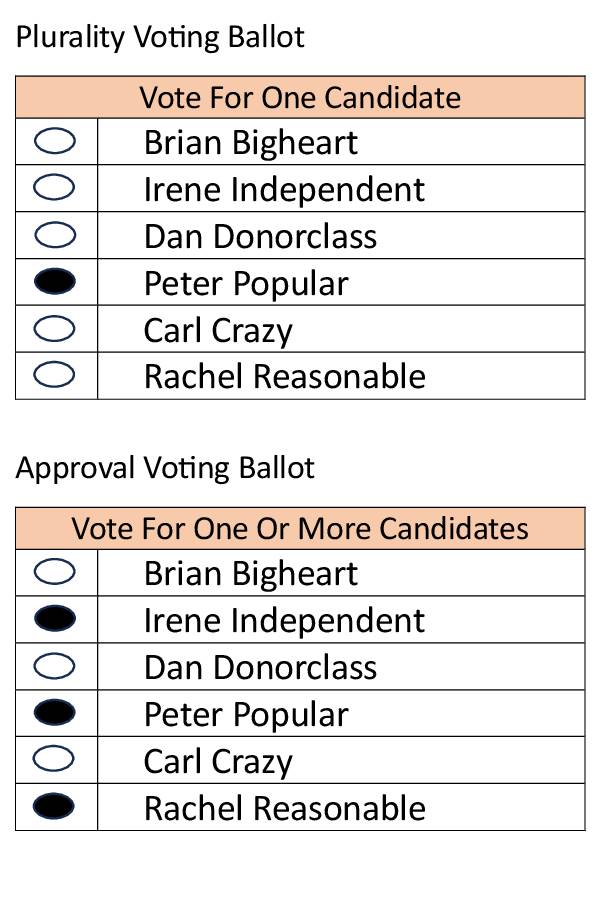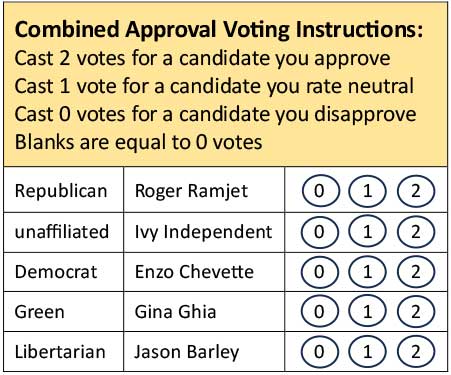Approval Voting for Single Winner Elections
A Simple Method That Works
You can only vote for one candidate with our current method, Choose 1 plurality voting. Approval voting lets you vote for one or more candidates. This eliminates the Spoiler Effect, because you can vote for your preferred major party candidate and your favorite third-party or independent candidate.
Approval Voting (AV) Advantages
Vote for multiple candidates with AV.
The candidate who receives the most votes wins.
No Spoiler Effect or Vote Splitting
You can safely vote for your favorite candidate.
AV rewards candidates with broad support.
Civilized Campaigns
Approval voting is fair to all candidates and rewards those with wide appeal. To win, candidates must reach beyond their base. This is a powerful incentive to run positive campaigns. Divisive rhetoric may trigger disapprovals. Too many current campaigns focus on getting out the base with messages of anger.
Center for Election Science Creative Commons 4.0 Attribution license
Superior to Choose 1 Voting
No voting system is perfect, but the method we use in most elections, Choose 1 voting has serious problems.
The powers that be will oppose any voting method proposed to replace Choose 1 voting, because the defects of Choose 1 preserve two-party rule.
Easy Change
Except for the instructions, approval ballots are the same as Choose 1 ballots. All voting machines can handle AV ballots and we can count the results at each polling location.
Choose 1 plurality and Approval ballots

Spoiled ballots are reduced with Approval voting. Most spoiled ballots occur when a voter marks two candidates. Two marks are fine in an Approval election.
Eliminate the Spoiler Effect
In a race with a good minor party candidate, you often must vote for a mediocre major party candidate to prevent a terrible one from winning. Good has no chance. The spoiler effect is removed by Approval voting. You can vote for the good candidate and the major party candidate you prefer.
The spoiler effect causes “minor” candidates to lose votes in every election. Their voter support is always under reported. Efforts to create publicity, recruit members, raise funds, and win elections are sabotaged. This is a key reason why our political system is stuck in the swamp.
The spoiler effect can also beat major party candidates like Al Gore in 2000. Will Biden or Trump be next?
Vote Splitting and Primary Elections
When candidates have similar platforms, they split the votes of like-minded voters, allowing a weak opponent to win. Quite like spoilers, these candidates are “clones”. Again, AV solves the problem by letting us vote for more than one candidate.
The purpose of primary elections is to determine the candidate with the broadest support among a group of similar contenders. AV is well suited for this task.
Center Squeeze Effect
If candidate Mary Moderate is preferred by fellow moderates and is the second choice for both Republicans and Democrats, Mary likely has the highest overall support.
To squeeze Mary out of the race, conservative and liberal candidates will woo moderate voters. If they think they can get away with it, some candidates will send different messages to different groups. With Approval voting Mary Moderate will have a fair chance to prove her support.
Resistance to Organized Strategy
A strategic voting campaign must have precise knowledge of voter intent to create a winning strategy. Many voters would need to be organized. In an AV race, a strategic campaign could easily hurt the wrong candidate.
Choose 1 voting has a strategic weakness. A SuperPAC can run an independent candidate who will draw votes from the candidate they dislike.
Strategy for Approval Voters
The Center for Election Science, the leading proponent for Approval voting, suggests this 2-Step strategy for voters:
Step 1: Who is likely to win? Consider the relative utility of each. Of those candidates, approve all whom you prefer. You may end up voting for more than one candidate within this group depending on whom is challenging your preferred candidate(s).
Step 2: Who is less likely to win? Of those candidates, approve of all you wish to give support.
In all cases, you can safely approve your favorite candidate. If your favorite cannot beat the other candidates you like, your favorite may lose to the strongest candidate you dislike. The key question, must you vote for an average candidate to prevent a bad candidate from winning?
Approval voting works well if voters pursue their best interests as described above and ignore candidate pleas to “vote only for me”. A detailed AV strategy is shown in an appendix below the sources.
Combined Approval Voting (CAV)
Traditional CAV offers voters three choices: approve (1), neutral (0), and disapprove (-1). The highest score win.
An alternative CAV method complies with state constitutions that requiere election winners to hive the “highest” “greatest” or “largest” number of votes. Voters cast 2 votes for candidates they approve, 1 vote for neutral candidates and 0 votes for candidates they disapprove. Blanks equal 0 votes. The candidate with the highest number of votes wins.
Combined Approval Ballot

CAV shares the advantages of Approval voting; but it provides voters with three options instead of two. Your vote will better express your opinions of the candidates. AV and CAV will work best if voters study and rate all candidates.
Calm Campaigns
Candidates will need to avoid disapprovals in AV and CAV elections. Voters could punish divisive campaigns. AV and CAV reward candidates with broad support.
Approval Voting in America
On June 9th 2020, Fargo ND became the first US city to use AV, electing John Strand and Arlette Preston to the City Commission. This was a two-winner at-large election with seven candidates. Yes, you can use AV in multi-winner elections. Fargo held their second AV election in 2022.[1]
The City of St. Louis Missouri uses AV in open primaries for mayor and Board of Aldermen with top two run-offs.
Organizations Using Approval Voting
United Nations to elect the Secretary General
Mathematical Association of America
American Statistical Association
Given the advantages of Approval and Combined Approval voting over
Choose 1 voting, we predict increased adoption in future elections.
More Strategy for Approval Voters
A detailed voter strategy is shown below the sources.
Sources
[1] Fargo’s Second Approval Election
The Center for Election Science, Electowiki, and Robert J. Weber, the inventor of Approval Voting, are the primary sources for this article.
The leading proponent for Approval voting is the Center for Election Science. Their site has many articles about Approval voting and election theory.
Combined Approval Voting (CAV) on Wikipedia – Combined Approval Voting is a great resource for voting systems and government structure.
Electowiki provides a thorough explanation of AV here.
Robert J. Weber, the originator of Approval voting presents a technical argument supporting the utility of his creation in his paper Approval Voting.
In 2010 Jean-Francois Laslier conducted a pole of 22 participants in a voting procedures workshop, including leading proponents of the Condorcet principle and Alternative voting (the traditional name for Ranked Choice voting).
When Laslier proposed using Approval voting for the poll no one objected, as Approval voting works well for polls with many candidates, in this case eighteen voting systems.
Approval voting won with 16 out of a possible 22 approvals, Alternative Voting (RCV) was second with 10 approvals. Choose One Plurality voting received zero approvals. Read Lasliers’s report.
Appendix – Detailed Approval Voting Strategy
In all approval races, you can safely approve your favorite candidate. If your favorite cannot beat the other candidates you like, your favorite may lose to the strongest candidate you dislike. The key question is, must you vote for an average candidate to prevent a bad candidate from winning?
For these examples, Rachel Reasonable is your favorite candidate. You also like Peter Popular, but not as much. Dan Donorclass is the major party candidate you fear. The other candidates, Bob Bigmouth, Irene Independent and Carl Crazy, are not popular or well-funded. They have no chance of winning.
In all cases, you can safely approve your favorite candidate and support for any or all the “minor” candidates who do not have a chance of winning: Bob Bigmouth, Irene Independent and Carl Crazy.
1 – The polls show a very close race between Rachel Reasonable, Peter Popular and Dan Donorclass. Your primary concern is to prevent Dan Donorclass from winning. Approve the candidates you prefer to Dan who have a real chance of defeating him; Rachel Reasonable and Peter Popular.
2 – The polls show a very close race between Rachel Reasonable and Peter Popular; Dan Donorclass has no chance of winning. Here you would vote for Rachel Reasonable, but not Peter; because a vote for Peter could cause Rachel to lose.
3 – Dan Donorclass and Peter Popular are in a very close race, Rachel Reasonable has little hope. You vote for Peter to help him defeat Dan and you vote for Rachel to express your support for her.
4 – Dan Donorclass and Rachel Reasonable are in a very close race. Peter Popular is not so popular, he has little hope. Vote for Rachel, your favorite. You could vote for Peter if you want to express support for him.
How should you vote if you do not have trustworthy polling information? Example 1 covers the situation when you fear a candidate like Dan Donorclass; you approve all candidates better than Dan who have a chance at beating Dan.
What if you fear none of the candidates? Always vote for your favorite candidate. If you are not sure your favorite can beat the leading candidate you dislike, vote for the candidate(s) who are significantly better.
If your favorite cannot beat the other candidates you like, your favorite will probably lose to the strongest candidate you dislike.
Many candidates will tell their supporters to “vote only for me”. If you heed this request, you may harm the chances of your second favorite candidate and help candidates you dislike. If all voters only choose their favorite candidate, Approval voting will work just like Choose One voting.
Approval voting works well if voters pursue their best interests as described above and ignore candidate pleas to “vote only for me.”


